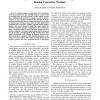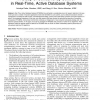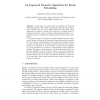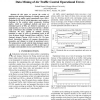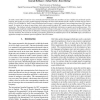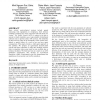CHI
2011
ACM
13 years 6 months ago
2011
ACM
Numerous applications such as simulations, air traffic control systems, and video surveillance systems are inherently composed of spatial objects that move in a scene. In many ins...
CSCW
2011
ACM
13 years 9 months ago
2011
ACM
Collaboration is key to safety and efficiency in Air Traffic Control. Legacy paper-based systems enable seamless and non-verbal collaboration, but trends in new software and hardw...
CDC
2010
IEEE
13 years 9 months ago
2010
IEEE
Dynamic airspace configuration (DAC) algorithms strive to restructure the U.S. National Airspace System (NAS) in ways that allow air traffic control to better manage aircraft flows...
TKDE
2002
14 years 2 months ago
2002
HM
2010
Springer
14 years 2 months ago
2010
Springer
In this paper we consider solving a complex real life break scheduling problem. This problem of high practical relevance arises in many working areas, e.g. in air traffic control a...
WSC
1998
14 years 4 months ago
1998
The Detailed Policy Assessment Tool (DPAT) is a widely used simulation of air traffic control that incorporates advanced technology for user-friendly operation. DPAT computes cong...
DMIN
2006
14 years 4 months ago
2006
In this paper we present the results of applying data mining techniques to identify patterns and anomalies in air traffic control operational errors (OEs). Reducing the OE rate is ...
AIIDE
2006
14 years 4 months ago
2006
Flight simulators are becoming more sophisticated and realistic, and the requirements of those using them are becoming more demanding. Air traffic control simulation for such simu...
LREC
2008
14 years 4 months ago
2008
Air traffic control (ATC) is based on voice communication between pilots and controllers and uses a highly task and domain specific language. Due to this very reason, spoken langu...
ATAL
2008
Springer
14 years 4 months ago
2008
Springer
Since critical socio-technical systems include people interacting with equipments in workplaces, their intrinsic reliability problems have been concerned with both these two "...

